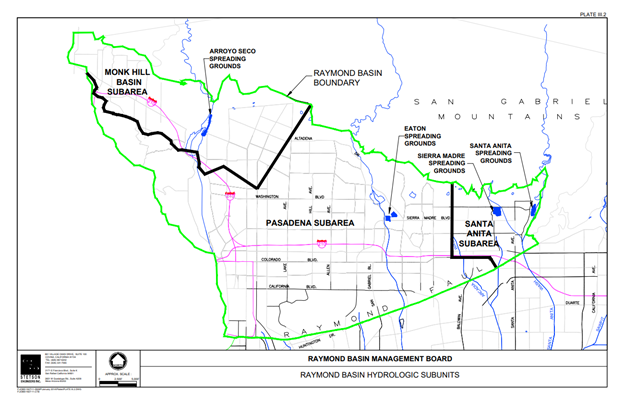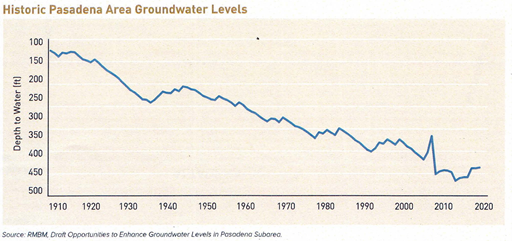The City of Pasadena Water and Power Department has proposed the Arroyo Seco Canyon Project to expand the set of basins for capturing and spreading streamflow in the upper portion of the Arroyo Seco. The spreading basins increase the amount of water that soaks into the ground and into the underlying Raymond groundwater basin, recharging the aquifer.
The Raymond Basin is a forty-square-mile natural aquifer underlying much of Pasadena, Altadena, Sierra Madre, and part of Arcadia. The Raymond Basin water originates as surface water from the San Gabriel Mountains. The city of Pasadena obtains 35 percent of its municipal water supply from the Raymond Basin. Imported water purchased from the Metropolitan Water District supplements Pasadena’s local supply. The Raymond Basin judgment (a court decision establishing rights for production and use of groundwater) allows the city of Pasadena to increase its pumping to include 60 percent of the increased recharge to the Raymond Basin accomplished through the spreading basins. The basin retains the remaining 40 percent of the water.

Map of the Raymond Basin. (Courtesy of Raymond Basin Management Board)
The Pasadena Water Department maintains that water not captured in the Arroyo Seco spreading basins flows out of the Raymond Basin to a concrete-lined channel and eventually reaches the ocean.
Opponents of the project, including the Arroyo Seco Foundation, state that the spreading basins are ugly and remove fish and wildlife habitat in the streambed, that existing spreading basins are underutilized, and that the water would recharge the basin naturally without expansion and operation of the basins by the water department. Opponents also argue that the Raymond Basin groundwater levels would be adversely affected by the project due to Pasadena’s increased pumping.
Pasadena proposes to undertake the project to reduce its reliance on imported water and to increase use of locally available water. The city council is scheduled to consider the project on February 7.

Historic Pasadena area groundwater levels. (Courtesy of Pasadena Water and Power)
—Kathy Kunysz, Natural Resources Committee